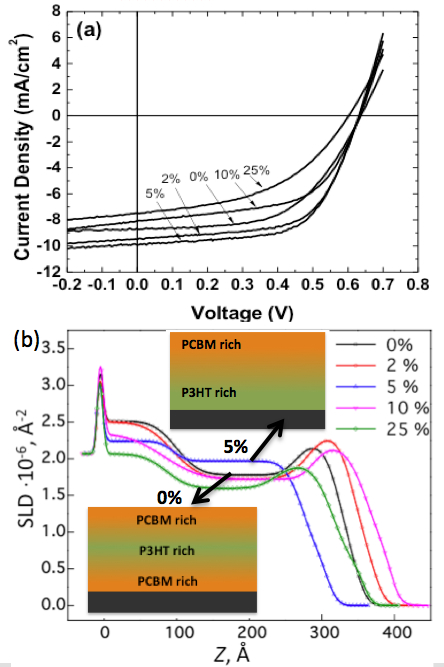PS-b-P3HT Copolymers as P3HT/PCBM Interfacial Compatibilizers for High Efficiency Photovoltaics
Zhenzhong Sun1, Kai Xiao2,*, Jong Keum3, Xiang Yu2, Kunlun Hong2, Jim Browning3, Ilia Ivanov2, Jihua Chen2, Jose Alonzo3, Dawen Li1,*, Bobby Sumpter2, Andrew Payzant2, Christopher Rouleau2, David Geohegan2
1Department of Electrical and Computer Engineering, University of Alabama, Tuscaloosa, AL;
2Center for Nanophase Materials Sciences, Oak Ridge, TN;
3Neutron Scattering Science Division, Oak Ridge National Laboratory, Oak Ridge, TNPDF of article published in Advanced Materials 23 5529 (2011).
See this and other highlights at the (CNMS News and Highlights Page).
(a) Electrical characteristics of polymer solar cells with different fractions of diblock copolymer compatibilizers.
(b) Neutron reflectivity data and schematics illustrating how 5% diblock copolymers alter the PCBM distribution within the active layer of the device.
AchievementPolymer solar cell (PSC) performance often suffers from poor control over the electron donor/acceptor phase separation, as well as thermally unstable morphologies. Here, a promising pathway to control phase separation and improve the efficiency of PSCs is reported.
This work provides the understanding of how to simultaneously improve the morphology and transport properties of conducting polymer blends, an important pathway to achieve higher efficiencies (Fig. a) required for their practical utilization in solar cells, lighting, and flexible electronics.
Conducting diblock copolymers (PS-b-P3HT) were added to compatibilize donor (polythiophene, P3HT) and acceptor (phenyl-C61-butyric acid methyl ester, PCBM) polymers in solar cells. The addition of diblock copolymers controlled their nanoscale phase separation, yielding longer range crystallinity, and an optimal composition profile in the vertical direction to enhance hole transport in the devices.
Neutron reflectivity (Fig. b) demonstrated that the addition of block copolymer controlled the vertical morphology of the active layer, especially the PCBM distribution within the active layer of the device.
Quantum density functional theory calculations revealed that the interaction between the (PS-b-P3HT) copolymers and the PCBM electron acceptors was a major driving force to control phase separation. The PCBM acceptors were attracted to the insulating polystyrene (PS) block, while the P3HT donors aligned with the conducting P3HT block of the diblock copolymer.
Credit - This work was published in Advanced Materials, Nov. 18, 2011 DOI:10.1002/adma.201103361. This research was conducted at the Center for Nanophase Materials Sciences, with neutron reflectometry experiment performed on the Liquids Reflectometer at the Spallation Neutron Source, which are user facilities sponsored at Oak Ridge National Laboratory by the Office of Basic Energy Sciences, U.S. Department of Energy.

